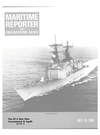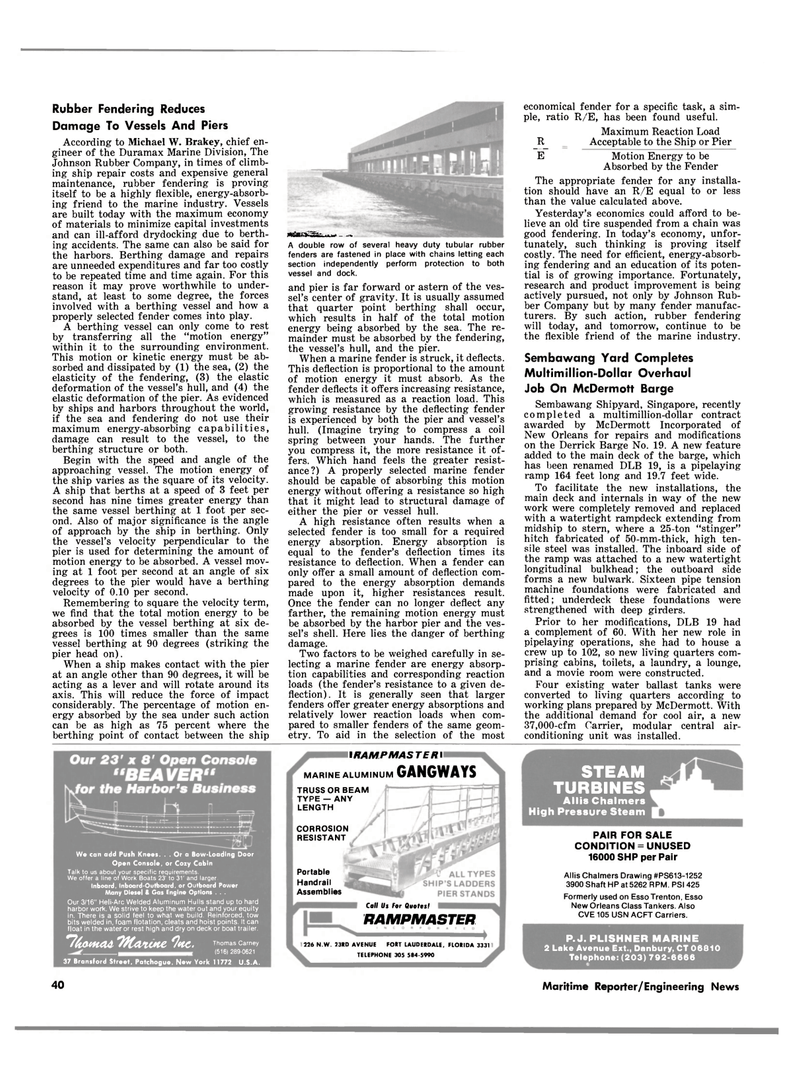
Page 38: of Maritime Reporter Magazine (July 15, 1981)
Read this page in Pdf, Flash or Html5 edition of July 15, 1981 Maritime Reporter Magazine
Rubber Fendering Reduces
Damage To Vessels And Piers
According to Michael W. Brakey, chief en- gineer of the Duramax Marine Division, The
Johnson Rubber Company, in times of climb- ing ship repair costs and expensive general maintenance, rubber fendering is proving itself to be a highly flexible, energy-absorb- ing friend to the marine industry. Vessels are built today with the maximum economy of materials to minimize capital investments and can ill-afford drydocking due to berth- ing accidents. The same can also be said for the harbors. Berthing damage and repairs are unneeded expenditures and far too costly to be repeated time and time again. For this reason it may prove worthwhile to under- stand, at least to some degree, the forces involved with a berthing vessel and how a properly selected fender comes into play.
A berthing vessel can only come to rest by transferring all the "motion energy" within it to the surrounding environment.
This motion or kinetic energy must be ab- sorbed and dissipated by (1) the sea, (2) the elasticity of the fendering, (3) the elastic deformation of the vessel's hull, and (4) the elastic deformation of the pier. As evidenced by ships and harbors throughout the world, if the sea and fendering do not use their maximum energy-absorbing capabilities, damage can result to the vessel, to the berthing structure or both.
Begin with the speed and angle of the approaching vessel. The motion energy of the ship varies as the square of its velocity.
A ship that berths at a speed of 3 feet per second has nine times greater energy than the same vessel berthing at 1 foot per sec- ond. Also of major significance is the angle of approach by the ship in berthing. Only the vessel's velocity perpendicular to the pier is used for determining the amount of motion energy to be absorbed. A vessel mov- ing at 1 foot per second at an angle of six degrees to the pier would have a berthing velocity of 0.10 per second.
Remembering to square the velocity term, we find that the total motion energy to be absorbed by the vessel berthing at six de- grees is 100 times smaller than the same vessel berthing at 90 degrees (striking the pier head on).
When a ship makes contact with the pier at an angle other than 90 degrees, it will be acting as a lever and will rotate around its axis. This will reduce the force of impact considerably. The percentage of motion en- ergy absorbed by the sea under such action can be as high as 75 percent where the berthing point of contact between the ship economical fender for a specific task, a sim- ple, ratio R/E, has been found useful.
Maximum Reaction Load
Acceptable to the Ship or Pier _R_
E Motion Energy to be
Absorbed by the Fender •jjif u —
A double row of several heavy duty tubular rubber fenders are fastened in place with chains letting each section independently perform protection to both vessel and dock. and pier is far forward or astern of the ves- sel's center of gravity. It is usually assumed that quarter point berthing shall occur, which results in half of the total motion energy being absorbed by the sea. The re- mainder must be absorbed by the fendering, the vessel's hull, and the pier.
When a marine fender is struck, it deflects.
This deflection is proportional to the amount of motion energy it must absorb. As the fender deflects it offers increasing resistance, which is measured as a reaction load. This growing resistance by the deflecting fender is experienced by both the pier and vessel's hull. (Imagine trying to compress a coil spring between your hands. The further you compress it, the more resistance it of- fers. Which hand feels the greater resist- ance?) A properly selected marine fender should be capable of absorbing this motion energy without offering a resistance so high that it might lead to structural damage of either the pier or vessel hull.
A high resistance often results when a selected fender is too small for a required energy absorption. Energy absorption is equal to the fender's deflection times its resistance to deflection. When a fender can only offer a small amount of deflection com- pared to the energy absorption demands made upon it, higher resistances result.
Once the fender can no longer deflect any farther, the remaining motion energy must be absorbed by the harbor pier and the ves- sel's shell. Here lies the danger of berthing damage.
Two factors to be weighed carefully in se- lecting a marine fender are energy absorp- tion capabilities and corresponding reaction loads (the fender's resistance to a given de- flection). It is generally seen that larger fenders offer greater energy absorptions and relatively lower reaction loads when com- pared to smaller fenders of the same geom- etry. To aid in the selection of the most
The appropriate fender for any installa- tion should have an R/E equal to or less than the value calculated above.
Yesterday's economics could afford to be- lieve an old tire suspended from a chain was good fendering. In today's economy, unfor- tunately, such thinking is proving itself costly. The need for efficient, energy-absorb- ing fendering and an education of its poten- tial is of growing importance. Fortunately, research and product improvement is being actively pursued, not only by Johnson Rub- ber Company but by many fender manufac- turers. By such action, rubber fendering will today, and tomorrow, continue to be the flexible friend of the marine industry.
Sembawang Yard Completes
Multimillion-Dollar Overhaul
Job On McDermott Barge
Sembawang Shipyard, Singapore, recently completed a multimillion-dollar contract awarded by McDermott Incorporated of
New Orleans for repairs and modifications on the Derrick Barge No. 19. A new feature added to the main deck of the barge, which has been renamed DLB 19, is a pipelaying ramp 164 feet long and 19.7 feet wide.
To facilitate the new installations, the main deck and internals in way of the new work were completely removed and replaced with a watertight rampdeck extending from midship to stern, where a 25-ton "stinger" hitch fabricated of 50-mm-thick, high ten- sile steel was installed. The inboard side of the ramp was attached to a new watertight longitudinal bulkhead; the outboard side forms a new bulwark. Sixteen pipe tension machine foundations were fabricated and fitted; underdeck these foundations were strengthened with deep girders.
Prior to her modifications, DLB 19 had a complement of 60. With her new role in pipelaying operations, she had to house a crew up to 102, so new living quarters com- prising cabins, toilets, a laundry, a lounge, and a movie room were constructed.
Four existing water ballast tanks were converted to living quarters according to working plans prepared by McDermott. With the additional demand for cool air, a new 37,000-cfm Carrier, modular central air- conditioning unit was installed.
We can add Push Knees. . . Or a Bow-Loading Door
Open Console, or Cozy Cabin
Talk to us about your specific requirements.
We offer a line of Work Boats 23' to 31' and larger
Inboard, Inboard-Outboard, or Outboard Power
Many Diesel & Gas Engine Options . . .
Our 3/16" Heli-Arc Welded Aluminum Hulls stand up to hard harbor work. We strive to keep the water out and your equity in. There is a solid feel to what we build. Reinforced, tow bits welded in, foam flotation, cleats and hoist points. It can float in the water or rest high and dry on deck or boat trailer.
Tfowuu Statute *)«tc. Thomas Came> (516| 289-0621 37 Bransford Street, Patchogue, New York 11772 U.S.A.
STEAM TURBINES
Allis Chalmers
High Pressure Steam
PAIR FOR SALE
CONDITION = UNUSED 16000 SHP per Pair
Allis Chalmers Drawing #PS613-1252 3900 Shaft HP at 5262 RPM. PSI 425
Formerly used on EssoTrenton, Esso
New Orleans Class Tankers. Also
CVE 105 USN ACFT Carriers. \RAMPMASTE R\
MARINE ALUMINUM GANGWAYS
TRUSS OR BEAM
TYPE — ANY
LENGTH
Call Us For Quotes!
RAMPMASTER 116 N.W. 23RD AVENUE FORT LAUDERDALE, FLORIDA
TELEPHONE 305 584-5990 3331
CORROSION
RESISTANT
Portable
Handrail
Assemblies
P.J. PLISHNER MARINE 2 Lake Avenue Ext., Danbury, CT 06810
Telephone: (203) 792-6666 40 Maritime Reporter/Engineering News

 37
37

 39
39
